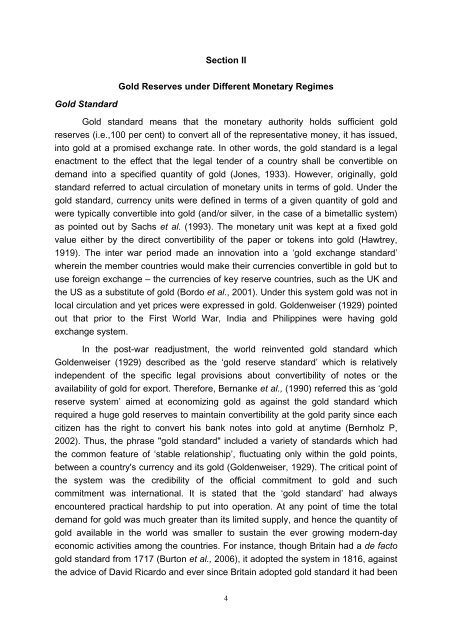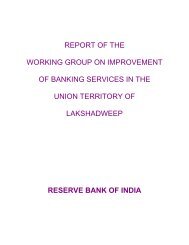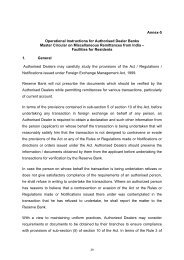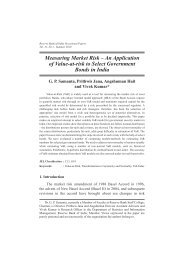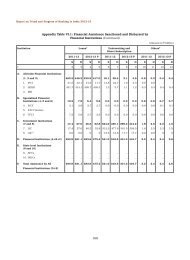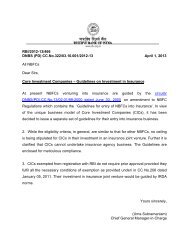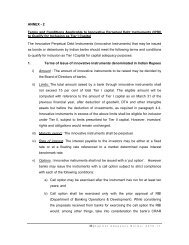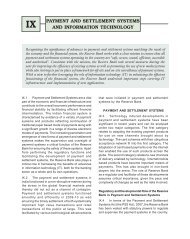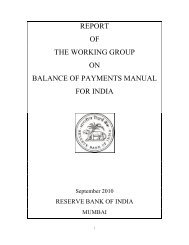Recent Global Crisis and the Demand for Gold - Reserve Bank of India
Recent Global Crisis and the Demand for Gold - Reserve Bank of India
Recent Global Crisis and the Demand for Gold - Reserve Bank of India
You also want an ePaper? Increase the reach of your titles
YUMPU automatically turns print PDFs into web optimized ePapers that Google loves.
Section II<br />
<strong>Gold</strong> <strong>Reserve</strong>s under Different Monetary Regimes<br />
<strong>Gold</strong> St<strong>and</strong>ard<br />
<strong>Gold</strong> st<strong>and</strong>ard means that <strong>the</strong> monetary authority holds sufficient gold<br />
reserves (i.e.,100 per cent) to convert all <strong>of</strong> <strong>the</strong> representative money, it has issued,<br />
into gold at a promised exchange rate. In o<strong>the</strong>r words, <strong>the</strong> gold st<strong>and</strong>ard is a legal<br />
enactment to <strong>the</strong> effect that <strong>the</strong> legal tender <strong>of</strong> a country shall be convertible on<br />
dem<strong>and</strong> into a specified quantity <strong>of</strong> gold (Jones, 1933). However, originally, gold<br />
st<strong>and</strong>ard referred to actual circulation <strong>of</strong> monetary units in terms <strong>of</strong> gold. Under <strong>the</strong><br />
gold st<strong>and</strong>ard, currency units were defined in terms <strong>of</strong> a given quantity <strong>of</strong> gold <strong>and</strong><br />
were typically convertible into gold (<strong>and</strong>/or silver, in <strong>the</strong> case <strong>of</strong> a bimetallic system)<br />
as pointed out by Sachs et al. (1993). The monetary unit was kept at a fixed gold<br />
value ei<strong>the</strong>r by <strong>the</strong> direct convertibility <strong>of</strong> <strong>the</strong> paper or tokens into gold (Hawtrey,<br />
1919). The inter war period made an innovation into a ‘gold exchange st<strong>and</strong>ard’<br />
wherein <strong>the</strong> member countries would make <strong>the</strong>ir currencies convertible in gold but to<br />
use <strong>for</strong>eign exchange – <strong>the</strong> currencies <strong>of</strong> key reserve countries, such as <strong>the</strong> UK <strong>and</strong><br />
<strong>the</strong> US as a substitute <strong>of</strong> gold (Bordo et al., 2001). Under this system gold was not in<br />
local circulation <strong>and</strong> yet prices were expressed in gold. <strong>Gold</strong>enweiser (1929) pointed<br />
out that prior to <strong>the</strong> First World War, <strong>India</strong> <strong>and</strong> Philippines were having gold<br />
exchange system.<br />
In <strong>the</strong> post-war readjustment, <strong>the</strong> world reinvented gold st<strong>and</strong>ard which<br />
<strong>Gold</strong>enweiser (1929) described as <strong>the</strong> ‘gold reserve st<strong>and</strong>ard’ which is relatively<br />
independent <strong>of</strong> <strong>the</strong> specific legal provisions about convertibility <strong>of</strong> notes or <strong>the</strong><br />
availability <strong>of</strong> gold <strong>for</strong> export. There<strong>for</strong>e, Bernanke et al., (1990) referred this as ‘gold<br />
reserve system’ aimed at economizing gold as against <strong>the</strong> gold st<strong>and</strong>ard which<br />
required a huge gold reserves to maintain convertibility at <strong>the</strong> gold parity since each<br />
citizen has <strong>the</strong> right to convert his bank notes into gold at anytime (Bernholz P,<br />
2002). Thus, <strong>the</strong> phrase "gold st<strong>and</strong>ard" included a variety <strong>of</strong> st<strong>and</strong>ards which had<br />
<strong>the</strong> common feature <strong>of</strong> ‘stable relationship’, fluctuating only within <strong>the</strong> gold points,<br />
between a country's currency <strong>and</strong> its gold (<strong>Gold</strong>enweiser, 1929). The critical point <strong>of</strong><br />
<strong>the</strong> system was <strong>the</strong> credibility <strong>of</strong> <strong>the</strong> <strong>of</strong>ficial commitment to gold <strong>and</strong> such<br />
commitment was international. It is stated that <strong>the</strong> ‘gold st<strong>and</strong>ard’ had always<br />
encountered practical hardship to put into operation. At any point <strong>of</strong> time <strong>the</strong> total<br />
dem<strong>and</strong> <strong>for</strong> gold was much greater than its limited supply, <strong>and</strong> hence <strong>the</strong> quantity <strong>of</strong><br />
gold available in <strong>the</strong> world was smaller to sustain <strong>the</strong> ever growing modern-day<br />
economic activities among <strong>the</strong> countries. For instance, though Britain had a de facto<br />
gold st<strong>and</strong>ard from 1717 (Burton et al., 2006), it adopted <strong>the</strong> system in 1816, against<br />
<strong>the</strong> advice <strong>of</strong> David Ricardo <strong>and</strong> ever since Britain adopted gold st<strong>and</strong>ard it had been<br />
4


